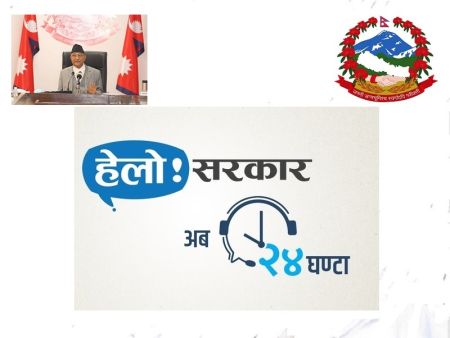Notice (8): Trying to access array offset on value of type null [APP/View/MagazineArticles/view.ctp, line 54]Code Context $user = $this->Session->read('Auth.User');
//find the group of logged user
$groupId = $user['Group']['id'];
$viewFile = '/var/www/html/newbusinessage.com/app/View/MagazineArticles/view.ctp'
$dataForView = array(
'magazineArticle' => array(
'MagazineArticle' => array(
'id' => '743',
'magazine_issue_id' => '565',
'magazine_category_id' => '0',
'title' => 'Monthly Technical Analysis of Nepse',
'image' => null,
'short_content' => null,
'content' => '<div>
</div>
<div>
Over the four trading weeks, February 21, 2014 to March 20, 2014, Nepal Stock Exchange Index (Nepse) witnessed a steep decline of 47.39 points (or -5.76%). However, Nepse has been able to maintain above its immediate support level of 753.17, which is a positive sign for the market in the near term. During this period RSI line reached oversold zone and bounced back to the neutral zone indicating marginal rise in buying pressure of the stocks. The MACD line also indicates that the domestic stock market is close to reaching one of the lowest points of the oversold zone. The On Balance Volume (OBV) indicator is also close to reaching its support level noticed on January 01, 2014. All these technical indicators, except RSI, of Nepse index indicate that the stock market is hovering around the oversold zone, which may bring demand for stocks in the days to come. </div>
<div>
</div>
<div>
<span style="font-size:14px;"><strong><img alt="" src="/userfiles/images/ta1.JPG" style="float: right; margin: 0px 0px 0px 10px; width: 350px; height: 195px;" />Market Trend</strong></span></div>
<div>
During the last four trading weeks, Nepse witnessed declining trend. This indicates that the positive sentiment that was seen after CA elections until last month could not be carried into this month. One of the major reasons for this bearish movement of Nepse is lower investor confidence towards the statement of Nepal Rastra Bank (NRB) in its mid-term review of monetary policy for FY 2070/71. In this statement NRB had indicated a possible tightening on margin lending to prevent a bubble in Nepal’s one and only stock market, Nepse. This resulted in Nepse crossing below its 50-day moving average, which can be viewed as a short-term downward trend. However, currently, the market is trading above a strong support level at 753.17 points. If Nepse could break this level, it would have indicated further bear trend. However the stock market is well above its 200-day moving average suggesting that the longer-term trend of the market is still positive. </div>
<div>
</div>
<div>
<span style="font-size:14px;"><strong>Relative Strength Index (RSI)</strong></span></div>
<div>
Relative Strength Index is a form of leading indicator that is believed to be most effective during periods of sideways movement. Such indicators may create numerous buy and sell signals that are useful when the market is not clearly trending upwards or downwards. The RSI index has been trending lower and then narrowly avoiding the oversold zone at 30.65 levels on Mar 18, 2014. During the final trading day of the last week, RSI closed at 43.32 levels due </div>
<div>
to an increase in buying. This indicated that the market is still in a neutral zone. </div>
<div>
</div>
<div>
<span style="font-size:14px;"><strong>Moving Average Convergence Divergence (MACD</strong></span>)</div>
<div>
The MACD is a momentum oscillator formed by using two different types of moving averages, which provide specific buying or selling signals. When a MACD line crosses above the signal line, it is considered to be a positive sign and indicates a time to buy, and vice-versa. The MACD line and Signal line currently stands at negative (-6.31) and (-0.44) points respectively showing that the overall recent momentum has been in the downward direction. Over the past 4 weeks, the MACD line and Signal line have both been trending lower. On Mar 04, 2014, the MACD line crossed below the Signal line once again suggesting that the near term moving average is falling at a greater momentum than the longer term moving average.</div>
<div>
</div>
<div>
<img alt="Technical Analysis" src="/userfiles/images/ta(3).jpg" style="width: 550px; height: 288px; margin-left: 10px; margin-right: 10px;" /></div>
<div>
</div>
<div>
<span style="font-size:14px;"><strong>On Balance Volume (OBV)</strong></span></div>
<div>
On Balance Volume is also a momentum indicator that relates volume to the current price of index or security. If a price increase is supported by OBV, it confirms an uptrend, whereas if decrease in price is supported by OBV, it confirms a downtrend. The theory behind OBV is that volume precedes price. Over the last 4 trading weeks, the OBV indicator fell lower indicating that the number of shares traded have been on a declining trend in recent times. The OBV neared a support level maintained on January 01, 2014. If this support level does not break, there may be a rebound in volume in the near term.</div>',
'status' => true,
'publish_date' => '0000-00-00',
'created' => '2014-04-20 00:00:00',
'modified' => '0000-00-00 00:00:00',
'keywords' => 'new business age stock taking news & articles, stock taking news & articles from new business age nepal, stock taking headlines from nepal, current and latest stock taking news from nepal, economic news from nepal, nepali stock taking economic news and events, ongoing stock taking news of nepal',
'description' => 'Over the four trading weeks, February 21, 2014 to March 20, 2014, Nepal Stock Exchange Index (Nepse) witnessed a steep decline of 47.39 points (or -5.76%).',
'sortorder' => '716',
'feature_article' => true,
'user_id' => '0',
'image1' => null,
'image2' => null,
'image3' => null,
'image4' => null
),
'MagazineIssue' => array(
'id' => '565',
'image' => 'small_1397370914.jpg',
'sortorder' => '460',
'published' => true,
'created' => '2014-04-12 11:35:19',
'modified' => null,
'title' => 'Stock Taking',
'publish_date' => '2014-04-01',
'parent_id' => '541',
'homepage' => false,
'user_id' => '0'
),
'MagazineCategory' => array(
'id' => null,
'title' => null,
'sortorder' => null,
'status' => null,
'created' => null,
'homepage' => null,
'modified' => null
),
'User' => array(
'password' => '*****',
'id' => null,
'user_detail_id' => null,
'group_id' => null,
'username' => null,
'name' => null,
'email' => null,
'address' => null,
'gender' => null,
'access' => null,
'phone' => null,
'access_type' => null,
'activated' => null,
'sortorder' => null,
'published' => null,
'created' => null,
'last_login' => null,
'ip' => null
),
'MagazineArticleComment' => array(),
'MagazineView' => array(
(int) 0 => array(
[maximum depth reached]
)
)
),
'current_user' => null,
'logged_in' => false
)
$magazineArticle = array(
'MagazineArticle' => array(
'id' => '743',
'magazine_issue_id' => '565',
'magazine_category_id' => '0',
'title' => 'Monthly Technical Analysis of Nepse',
'image' => null,
'short_content' => null,
'content' => '<div>
</div>
<div>
Over the four trading weeks, February 21, 2014 to March 20, 2014, Nepal Stock Exchange Index (Nepse) witnessed a steep decline of 47.39 points (or -5.76%). However, Nepse has been able to maintain above its immediate support level of 753.17, which is a positive sign for the market in the near term. During this period RSI line reached oversold zone and bounced back to the neutral zone indicating marginal rise in buying pressure of the stocks. The MACD line also indicates that the domestic stock market is close to reaching one of the lowest points of the oversold zone. The On Balance Volume (OBV) indicator is also close to reaching its support level noticed on January 01, 2014. All these technical indicators, except RSI, of Nepse index indicate that the stock market is hovering around the oversold zone, which may bring demand for stocks in the days to come. </div>
<div>
</div>
<div>
<span style="font-size:14px;"><strong><img alt="" src="/userfiles/images/ta1.JPG" style="float: right; margin: 0px 0px 0px 10px; width: 350px; height: 195px;" />Market Trend</strong></span></div>
<div>
During the last four trading weeks, Nepse witnessed declining trend. This indicates that the positive sentiment that was seen after CA elections until last month could not be carried into this month. One of the major reasons for this bearish movement of Nepse is lower investor confidence towards the statement of Nepal Rastra Bank (NRB) in its mid-term review of monetary policy for FY 2070/71. In this statement NRB had indicated a possible tightening on margin lending to prevent a bubble in Nepal’s one and only stock market, Nepse. This resulted in Nepse crossing below its 50-day moving average, which can be viewed as a short-term downward trend. However, currently, the market is trading above a strong support level at 753.17 points. If Nepse could break this level, it would have indicated further bear trend. However the stock market is well above its 200-day moving average suggesting that the longer-term trend of the market is still positive. </div>
<div>
</div>
<div>
<span style="font-size:14px;"><strong>Relative Strength Index (RSI)</strong></span></div>
<div>
Relative Strength Index is a form of leading indicator that is believed to be most effective during periods of sideways movement. Such indicators may create numerous buy and sell signals that are useful when the market is not clearly trending upwards or downwards. The RSI index has been trending lower and then narrowly avoiding the oversold zone at 30.65 levels on Mar 18, 2014. During the final trading day of the last week, RSI closed at 43.32 levels due </div>
<div>
to an increase in buying. This indicated that the market is still in a neutral zone. </div>
<div>
</div>
<div>
<span style="font-size:14px;"><strong>Moving Average Convergence Divergence (MACD</strong></span>)</div>
<div>
The MACD is a momentum oscillator formed by using two different types of moving averages, which provide specific buying or selling signals. When a MACD line crosses above the signal line, it is considered to be a positive sign and indicates a time to buy, and vice-versa. The MACD line and Signal line currently stands at negative (-6.31) and (-0.44) points respectively showing that the overall recent momentum has been in the downward direction. Over the past 4 weeks, the MACD line and Signal line have both been trending lower. On Mar 04, 2014, the MACD line crossed below the Signal line once again suggesting that the near term moving average is falling at a greater momentum than the longer term moving average.</div>
<div>
</div>
<div>
<img alt="Technical Analysis" src="/userfiles/images/ta(3).jpg" style="width: 550px; height: 288px; margin-left: 10px; margin-right: 10px;" /></div>
<div>
</div>
<div>
<span style="font-size:14px;"><strong>On Balance Volume (OBV)</strong></span></div>
<div>
On Balance Volume is also a momentum indicator that relates volume to the current price of index or security. If a price increase is supported by OBV, it confirms an uptrend, whereas if decrease in price is supported by OBV, it confirms a downtrend. The theory behind OBV is that volume precedes price. Over the last 4 trading weeks, the OBV indicator fell lower indicating that the number of shares traded have been on a declining trend in recent times. The OBV neared a support level maintained on January 01, 2014. If this support level does not break, there may be a rebound in volume in the near term.</div>',
'status' => true,
'publish_date' => '0000-00-00',
'created' => '2014-04-20 00:00:00',
'modified' => '0000-00-00 00:00:00',
'keywords' => 'new business age stock taking news & articles, stock taking news & articles from new business age nepal, stock taking headlines from nepal, current and latest stock taking news from nepal, economic news from nepal, nepali stock taking economic news and events, ongoing stock taking news of nepal',
'description' => 'Over the four trading weeks, February 21, 2014 to March 20, 2014, Nepal Stock Exchange Index (Nepse) witnessed a steep decline of 47.39 points (or -5.76%).',
'sortorder' => '716',
'feature_article' => true,
'user_id' => '0',
'image1' => null,
'image2' => null,
'image3' => null,
'image4' => null
),
'MagazineIssue' => array(
'id' => '565',
'image' => 'small_1397370914.jpg',
'sortorder' => '460',
'published' => true,
'created' => '2014-04-12 11:35:19',
'modified' => null,
'title' => 'Stock Taking',
'publish_date' => '2014-04-01',
'parent_id' => '541',
'homepage' => false,
'user_id' => '0'
),
'MagazineCategory' => array(
'id' => null,
'title' => null,
'sortorder' => null,
'status' => null,
'created' => null,
'homepage' => null,
'modified' => null
),
'User' => array(
'password' => '*****',
'id' => null,
'user_detail_id' => null,
'group_id' => null,
'username' => null,
'name' => null,
'email' => null,
'address' => null,
'gender' => null,
'access' => null,
'phone' => null,
'access_type' => null,
'activated' => null,
'sortorder' => null,
'published' => null,
'created' => null,
'last_login' => null,
'ip' => null
),
'MagazineArticleComment' => array(),
'MagazineView' => array(
(int) 0 => array(
'magazine_article_id' => '743',
'hit' => '1355'
)
)
)
$current_user = null
$logged_in = false
$user = null
include - APP/View/MagazineArticles/view.ctp, line 54
View::_evaluate() - CORE/Cake/View/View.php, line 971
View::_render() - CORE/Cake/View/View.php, line 933
View::render() - CORE/Cake/View/View.php, line 473
Controller::render() - CORE/Cake/Controller/Controller.php, line 968
Dispatcher::_invoke() - CORE/Cake/Routing/Dispatcher.php, line 200
Dispatcher::dispatch() - CORE/Cake/Routing/Dispatcher.php, line 167
[main] - APP/webroot/index.php, line 117
Notice (8): Trying to access array offset on value of type null [APP/View/MagazineArticles/view.ctp, line 54]Code Context $user = $this->Session->read('Auth.User');
//find the group of logged user
$groupId = $user['Group']['id'];
$viewFile = '/var/www/html/newbusinessage.com/app/View/MagazineArticles/view.ctp'
$dataForView = array(
'magazineArticle' => array(
'MagazineArticle' => array(
'id' => '743',
'magazine_issue_id' => '565',
'magazine_category_id' => '0',
'title' => 'Monthly Technical Analysis of Nepse',
'image' => null,
'short_content' => null,
'content' => '<div>
</div>
<div>
Over the four trading weeks, February 21, 2014 to March 20, 2014, Nepal Stock Exchange Index (Nepse) witnessed a steep decline of 47.39 points (or -5.76%). However, Nepse has been able to maintain above its immediate support level of 753.17, which is a positive sign for the market in the near term. During this period RSI line reached oversold zone and bounced back to the neutral zone indicating marginal rise in buying pressure of the stocks. The MACD line also indicates that the domestic stock market is close to reaching one of the lowest points of the oversold zone. The On Balance Volume (OBV) indicator is also close to reaching its support level noticed on January 01, 2014. All these technical indicators, except RSI, of Nepse index indicate that the stock market is hovering around the oversold zone, which may bring demand for stocks in the days to come. </div>
<div>
</div>
<div>
<span style="font-size:14px;"><strong><img alt="" src="/userfiles/images/ta1.JPG" style="float: right; margin: 0px 0px 0px 10px; width: 350px; height: 195px;" />Market Trend</strong></span></div>
<div>
During the last four trading weeks, Nepse witnessed declining trend. This indicates that the positive sentiment that was seen after CA elections until last month could not be carried into this month. One of the major reasons for this bearish movement of Nepse is lower investor confidence towards the statement of Nepal Rastra Bank (NRB) in its mid-term review of monetary policy for FY 2070/71. In this statement NRB had indicated a possible tightening on margin lending to prevent a bubble in Nepal’s one and only stock market, Nepse. This resulted in Nepse crossing below its 50-day moving average, which can be viewed as a short-term downward trend. However, currently, the market is trading above a strong support level at 753.17 points. If Nepse could break this level, it would have indicated further bear trend. However the stock market is well above its 200-day moving average suggesting that the longer-term trend of the market is still positive. </div>
<div>
</div>
<div>
<span style="font-size:14px;"><strong>Relative Strength Index (RSI)</strong></span></div>
<div>
Relative Strength Index is a form of leading indicator that is believed to be most effective during periods of sideways movement. Such indicators may create numerous buy and sell signals that are useful when the market is not clearly trending upwards or downwards. The RSI index has been trending lower and then narrowly avoiding the oversold zone at 30.65 levels on Mar 18, 2014. During the final trading day of the last week, RSI closed at 43.32 levels due </div>
<div>
to an increase in buying. This indicated that the market is still in a neutral zone. </div>
<div>
</div>
<div>
<span style="font-size:14px;"><strong>Moving Average Convergence Divergence (MACD</strong></span>)</div>
<div>
The MACD is a momentum oscillator formed by using two different types of moving averages, which provide specific buying or selling signals. When a MACD line crosses above the signal line, it is considered to be a positive sign and indicates a time to buy, and vice-versa. The MACD line and Signal line currently stands at negative (-6.31) and (-0.44) points respectively showing that the overall recent momentum has been in the downward direction. Over the past 4 weeks, the MACD line and Signal line have both been trending lower. On Mar 04, 2014, the MACD line crossed below the Signal line once again suggesting that the near term moving average is falling at a greater momentum than the longer term moving average.</div>
<div>
</div>
<div>
<img alt="Technical Analysis" src="/userfiles/images/ta(3).jpg" style="width: 550px; height: 288px; margin-left: 10px; margin-right: 10px;" /></div>
<div>
</div>
<div>
<span style="font-size:14px;"><strong>On Balance Volume (OBV)</strong></span></div>
<div>
On Balance Volume is also a momentum indicator that relates volume to the current price of index or security. If a price increase is supported by OBV, it confirms an uptrend, whereas if decrease in price is supported by OBV, it confirms a downtrend. The theory behind OBV is that volume precedes price. Over the last 4 trading weeks, the OBV indicator fell lower indicating that the number of shares traded have been on a declining trend in recent times. The OBV neared a support level maintained on January 01, 2014. If this support level does not break, there may be a rebound in volume in the near term.</div>',
'status' => true,
'publish_date' => '0000-00-00',
'created' => '2014-04-20 00:00:00',
'modified' => '0000-00-00 00:00:00',
'keywords' => 'new business age stock taking news & articles, stock taking news & articles from new business age nepal, stock taking headlines from nepal, current and latest stock taking news from nepal, economic news from nepal, nepali stock taking economic news and events, ongoing stock taking news of nepal',
'description' => 'Over the four trading weeks, February 21, 2014 to March 20, 2014, Nepal Stock Exchange Index (Nepse) witnessed a steep decline of 47.39 points (or -5.76%).',
'sortorder' => '716',
'feature_article' => true,
'user_id' => '0',
'image1' => null,
'image2' => null,
'image3' => null,
'image4' => null
),
'MagazineIssue' => array(
'id' => '565',
'image' => 'small_1397370914.jpg',
'sortorder' => '460',
'published' => true,
'created' => '2014-04-12 11:35:19',
'modified' => null,
'title' => 'Stock Taking',
'publish_date' => '2014-04-01',
'parent_id' => '541',
'homepage' => false,
'user_id' => '0'
),
'MagazineCategory' => array(
'id' => null,
'title' => null,
'sortorder' => null,
'status' => null,
'created' => null,
'homepage' => null,
'modified' => null
),
'User' => array(
'password' => '*****',
'id' => null,
'user_detail_id' => null,
'group_id' => null,
'username' => null,
'name' => null,
'email' => null,
'address' => null,
'gender' => null,
'access' => null,
'phone' => null,
'access_type' => null,
'activated' => null,
'sortorder' => null,
'published' => null,
'created' => null,
'last_login' => null,
'ip' => null
),
'MagazineArticleComment' => array(),
'MagazineView' => array(
(int) 0 => array(
[maximum depth reached]
)
)
),
'current_user' => null,
'logged_in' => false
)
$magazineArticle = array(
'MagazineArticle' => array(
'id' => '743',
'magazine_issue_id' => '565',
'magazine_category_id' => '0',
'title' => 'Monthly Technical Analysis of Nepse',
'image' => null,
'short_content' => null,
'content' => '<div>
</div>
<div>
Over the four trading weeks, February 21, 2014 to March 20, 2014, Nepal Stock Exchange Index (Nepse) witnessed a steep decline of 47.39 points (or -5.76%). However, Nepse has been able to maintain above its immediate support level of 753.17, which is a positive sign for the market in the near term. During this period RSI line reached oversold zone and bounced back to the neutral zone indicating marginal rise in buying pressure of the stocks. The MACD line also indicates that the domestic stock market is close to reaching one of the lowest points of the oversold zone. The On Balance Volume (OBV) indicator is also close to reaching its support level noticed on January 01, 2014. All these technical indicators, except RSI, of Nepse index indicate that the stock market is hovering around the oversold zone, which may bring demand for stocks in the days to come. </div>
<div>
</div>
<div>
<span style="font-size:14px;"><strong><img alt="" src="/userfiles/images/ta1.JPG" style="float: right; margin: 0px 0px 0px 10px; width: 350px; height: 195px;" />Market Trend</strong></span></div>
<div>
During the last four trading weeks, Nepse witnessed declining trend. This indicates that the positive sentiment that was seen after CA elections until last month could not be carried into this month. One of the major reasons for this bearish movement of Nepse is lower investor confidence towards the statement of Nepal Rastra Bank (NRB) in its mid-term review of monetary policy for FY 2070/71. In this statement NRB had indicated a possible tightening on margin lending to prevent a bubble in Nepal’s one and only stock market, Nepse. This resulted in Nepse crossing below its 50-day moving average, which can be viewed as a short-term downward trend. However, currently, the market is trading above a strong support level at 753.17 points. If Nepse could break this level, it would have indicated further bear trend. However the stock market is well above its 200-day moving average suggesting that the longer-term trend of the market is still positive. </div>
<div>
</div>
<div>
<span style="font-size:14px;"><strong>Relative Strength Index (RSI)</strong></span></div>
<div>
Relative Strength Index is a form of leading indicator that is believed to be most effective during periods of sideways movement. Such indicators may create numerous buy and sell signals that are useful when the market is not clearly trending upwards or downwards. The RSI index has been trending lower and then narrowly avoiding the oversold zone at 30.65 levels on Mar 18, 2014. During the final trading day of the last week, RSI closed at 43.32 levels due </div>
<div>
to an increase in buying. This indicated that the market is still in a neutral zone. </div>
<div>
</div>
<div>
<span style="font-size:14px;"><strong>Moving Average Convergence Divergence (MACD</strong></span>)</div>
<div>
The MACD is a momentum oscillator formed by using two different types of moving averages, which provide specific buying or selling signals. When a MACD line crosses above the signal line, it is considered to be a positive sign and indicates a time to buy, and vice-versa. The MACD line and Signal line currently stands at negative (-6.31) and (-0.44) points respectively showing that the overall recent momentum has been in the downward direction. Over the past 4 weeks, the MACD line and Signal line have both been trending lower. On Mar 04, 2014, the MACD line crossed below the Signal line once again suggesting that the near term moving average is falling at a greater momentum than the longer term moving average.</div>
<div>
</div>
<div>
<img alt="Technical Analysis" src="/userfiles/images/ta(3).jpg" style="width: 550px; height: 288px; margin-left: 10px; margin-right: 10px;" /></div>
<div>
</div>
<div>
<span style="font-size:14px;"><strong>On Balance Volume (OBV)</strong></span></div>
<div>
On Balance Volume is also a momentum indicator that relates volume to the current price of index or security. If a price increase is supported by OBV, it confirms an uptrend, whereas if decrease in price is supported by OBV, it confirms a downtrend. The theory behind OBV is that volume precedes price. Over the last 4 trading weeks, the OBV indicator fell lower indicating that the number of shares traded have been on a declining trend in recent times. The OBV neared a support level maintained on January 01, 2014. If this support level does not break, there may be a rebound in volume in the near term.</div>',
'status' => true,
'publish_date' => '0000-00-00',
'created' => '2014-04-20 00:00:00',
'modified' => '0000-00-00 00:00:00',
'keywords' => 'new business age stock taking news & articles, stock taking news & articles from new business age nepal, stock taking headlines from nepal, current and latest stock taking news from nepal, economic news from nepal, nepali stock taking economic news and events, ongoing stock taking news of nepal',
'description' => 'Over the four trading weeks, February 21, 2014 to March 20, 2014, Nepal Stock Exchange Index (Nepse) witnessed a steep decline of 47.39 points (or -5.76%).',
'sortorder' => '716',
'feature_article' => true,
'user_id' => '0',
'image1' => null,
'image2' => null,
'image3' => null,
'image4' => null
),
'MagazineIssue' => array(
'id' => '565',
'image' => 'small_1397370914.jpg',
'sortorder' => '460',
'published' => true,
'created' => '2014-04-12 11:35:19',
'modified' => null,
'title' => 'Stock Taking',
'publish_date' => '2014-04-01',
'parent_id' => '541',
'homepage' => false,
'user_id' => '0'
),
'MagazineCategory' => array(
'id' => null,
'title' => null,
'sortorder' => null,
'status' => null,
'created' => null,
'homepage' => null,
'modified' => null
),
'User' => array(
'password' => '*****',
'id' => null,
'user_detail_id' => null,
'group_id' => null,
'username' => null,
'name' => null,
'email' => null,
'address' => null,
'gender' => null,
'access' => null,
'phone' => null,
'access_type' => null,
'activated' => null,
'sortorder' => null,
'published' => null,
'created' => null,
'last_login' => null,
'ip' => null
),
'MagazineArticleComment' => array(),
'MagazineView' => array(
(int) 0 => array(
'magazine_article_id' => '743',
'hit' => '1355'
)
)
)
$current_user = null
$logged_in = false
$user = null
include - APP/View/MagazineArticles/view.ctp, line 54
View::_evaluate() - CORE/Cake/View/View.php, line 971
View::_render() - CORE/Cake/View/View.php, line 933
View::render() - CORE/Cake/View/View.php, line 473
Controller::render() - CORE/Cake/Controller/Controller.php, line 968
Dispatcher::_invoke() - CORE/Cake/Routing/Dispatcher.php, line 200
Dispatcher::dispatch() - CORE/Cake/Routing/Dispatcher.php, line 167
[main] - APP/webroot/index.php, line 117
Notice (8): Trying to access array offset on value of type null [APP/View/MagazineArticles/view.ctp, line 55]Code Context //find the group of logged user
$groupId = $user['Group']['id'];
$user_id=$user["id"];
$viewFile = '/var/www/html/newbusinessage.com/app/View/MagazineArticles/view.ctp'
$dataForView = array(
'magazineArticle' => array(
'MagazineArticle' => array(
'id' => '743',
'magazine_issue_id' => '565',
'magazine_category_id' => '0',
'title' => 'Monthly Technical Analysis of Nepse',
'image' => null,
'short_content' => null,
'content' => '<div>
</div>
<div>
Over the four trading weeks, February 21, 2014 to March 20, 2014, Nepal Stock Exchange Index (Nepse) witnessed a steep decline of 47.39 points (or -5.76%). However, Nepse has been able to maintain above its immediate support level of 753.17, which is a positive sign for the market in the near term. During this period RSI line reached oversold zone and bounced back to the neutral zone indicating marginal rise in buying pressure of the stocks. The MACD line also indicates that the domestic stock market is close to reaching one of the lowest points of the oversold zone. The On Balance Volume (OBV) indicator is also close to reaching its support level noticed on January 01, 2014. All these technical indicators, except RSI, of Nepse index indicate that the stock market is hovering around the oversold zone, which may bring demand for stocks in the days to come. </div>
<div>
</div>
<div>
<span style="font-size:14px;"><strong><img alt="" src="/userfiles/images/ta1.JPG" style="float: right; margin: 0px 0px 0px 10px; width: 350px; height: 195px;" />Market Trend</strong></span></div>
<div>
During the last four trading weeks, Nepse witnessed declining trend. This indicates that the positive sentiment that was seen after CA elections until last month could not be carried into this month. One of the major reasons for this bearish movement of Nepse is lower investor confidence towards the statement of Nepal Rastra Bank (NRB) in its mid-term review of monetary policy for FY 2070/71. In this statement NRB had indicated a possible tightening on margin lending to prevent a bubble in Nepal’s one and only stock market, Nepse. This resulted in Nepse crossing below its 50-day moving average, which can be viewed as a short-term downward trend. However, currently, the market is trading above a strong support level at 753.17 points. If Nepse could break this level, it would have indicated further bear trend. However the stock market is well above its 200-day moving average suggesting that the longer-term trend of the market is still positive. </div>
<div>
</div>
<div>
<span style="font-size:14px;"><strong>Relative Strength Index (RSI)</strong></span></div>
<div>
Relative Strength Index is a form of leading indicator that is believed to be most effective during periods of sideways movement. Such indicators may create numerous buy and sell signals that are useful when the market is not clearly trending upwards or downwards. The RSI index has been trending lower and then narrowly avoiding the oversold zone at 30.65 levels on Mar 18, 2014. During the final trading day of the last week, RSI closed at 43.32 levels due </div>
<div>
to an increase in buying. This indicated that the market is still in a neutral zone. </div>
<div>
</div>
<div>
<span style="font-size:14px;"><strong>Moving Average Convergence Divergence (MACD</strong></span>)</div>
<div>
The MACD is a momentum oscillator formed by using two different types of moving averages, which provide specific buying or selling signals. When a MACD line crosses above the signal line, it is considered to be a positive sign and indicates a time to buy, and vice-versa. The MACD line and Signal line currently stands at negative (-6.31) and (-0.44) points respectively showing that the overall recent momentum has been in the downward direction. Over the past 4 weeks, the MACD line and Signal line have both been trending lower. On Mar 04, 2014, the MACD line crossed below the Signal line once again suggesting that the near term moving average is falling at a greater momentum than the longer term moving average.</div>
<div>
</div>
<div>
<img alt="Technical Analysis" src="/userfiles/images/ta(3).jpg" style="width: 550px; height: 288px; margin-left: 10px; margin-right: 10px;" /></div>
<div>
</div>
<div>
<span style="font-size:14px;"><strong>On Balance Volume (OBV)</strong></span></div>
<div>
On Balance Volume is also a momentum indicator that relates volume to the current price of index or security. If a price increase is supported by OBV, it confirms an uptrend, whereas if decrease in price is supported by OBV, it confirms a downtrend. The theory behind OBV is that volume precedes price. Over the last 4 trading weeks, the OBV indicator fell lower indicating that the number of shares traded have been on a declining trend in recent times. The OBV neared a support level maintained on January 01, 2014. If this support level does not break, there may be a rebound in volume in the near term.</div>',
'status' => true,
'publish_date' => '0000-00-00',
'created' => '2014-04-20 00:00:00',
'modified' => '0000-00-00 00:00:00',
'keywords' => 'new business age stock taking news & articles, stock taking news & articles from new business age nepal, stock taking headlines from nepal, current and latest stock taking news from nepal, economic news from nepal, nepali stock taking economic news and events, ongoing stock taking news of nepal',
'description' => 'Over the four trading weeks, February 21, 2014 to March 20, 2014, Nepal Stock Exchange Index (Nepse) witnessed a steep decline of 47.39 points (or -5.76%).',
'sortorder' => '716',
'feature_article' => true,
'user_id' => '0',
'image1' => null,
'image2' => null,
'image3' => null,
'image4' => null
),
'MagazineIssue' => array(
'id' => '565',
'image' => 'small_1397370914.jpg',
'sortorder' => '460',
'published' => true,
'created' => '2014-04-12 11:35:19',
'modified' => null,
'title' => 'Stock Taking',
'publish_date' => '2014-04-01',
'parent_id' => '541',
'homepage' => false,
'user_id' => '0'
),
'MagazineCategory' => array(
'id' => null,
'title' => null,
'sortorder' => null,
'status' => null,
'created' => null,
'homepage' => null,
'modified' => null
),
'User' => array(
'password' => '*****',
'id' => null,
'user_detail_id' => null,
'group_id' => null,
'username' => null,
'name' => null,
'email' => null,
'address' => null,
'gender' => null,
'access' => null,
'phone' => null,
'access_type' => null,
'activated' => null,
'sortorder' => null,
'published' => null,
'created' => null,
'last_login' => null,
'ip' => null
),
'MagazineArticleComment' => array(),
'MagazineView' => array(
(int) 0 => array(
[maximum depth reached]
)
)
),
'current_user' => null,
'logged_in' => false
)
$magazineArticle = array(
'MagazineArticle' => array(
'id' => '743',
'magazine_issue_id' => '565',
'magazine_category_id' => '0',
'title' => 'Monthly Technical Analysis of Nepse',
'image' => null,
'short_content' => null,
'content' => '<div>
</div>
<div>
Over the four trading weeks, February 21, 2014 to March 20, 2014, Nepal Stock Exchange Index (Nepse) witnessed a steep decline of 47.39 points (or -5.76%). However, Nepse has been able to maintain above its immediate support level of 753.17, which is a positive sign for the market in the near term. During this period RSI line reached oversold zone and bounced back to the neutral zone indicating marginal rise in buying pressure of the stocks. The MACD line also indicates that the domestic stock market is close to reaching one of the lowest points of the oversold zone. The On Balance Volume (OBV) indicator is also close to reaching its support level noticed on January 01, 2014. All these technical indicators, except RSI, of Nepse index indicate that the stock market is hovering around the oversold zone, which may bring demand for stocks in the days to come. </div>
<div>
</div>
<div>
<span style="font-size:14px;"><strong><img alt="" src="/userfiles/images/ta1.JPG" style="float: right; margin: 0px 0px 0px 10px; width: 350px; height: 195px;" />Market Trend</strong></span></div>
<div>
During the last four trading weeks, Nepse witnessed declining trend. This indicates that the positive sentiment that was seen after CA elections until last month could not be carried into this month. One of the major reasons for this bearish movement of Nepse is lower investor confidence towards the statement of Nepal Rastra Bank (NRB) in its mid-term review of monetary policy for FY 2070/71. In this statement NRB had indicated a possible tightening on margin lending to prevent a bubble in Nepal’s one and only stock market, Nepse. This resulted in Nepse crossing below its 50-day moving average, which can be viewed as a short-term downward trend. However, currently, the market is trading above a strong support level at 753.17 points. If Nepse could break this level, it would have indicated further bear trend. However the stock market is well above its 200-day moving average suggesting that the longer-term trend of the market is still positive. </div>
<div>
</div>
<div>
<span style="font-size:14px;"><strong>Relative Strength Index (RSI)</strong></span></div>
<div>
Relative Strength Index is a form of leading indicator that is believed to be most effective during periods of sideways movement. Such indicators may create numerous buy and sell signals that are useful when the market is not clearly trending upwards or downwards. The RSI index has been trending lower and then narrowly avoiding the oversold zone at 30.65 levels on Mar 18, 2014. During the final trading day of the last week, RSI closed at 43.32 levels due </div>
<div>
to an increase in buying. This indicated that the market is still in a neutral zone. </div>
<div>
</div>
<div>
<span style="font-size:14px;"><strong>Moving Average Convergence Divergence (MACD</strong></span>)</div>
<div>
The MACD is a momentum oscillator formed by using two different types of moving averages, which provide specific buying or selling signals. When a MACD line crosses above the signal line, it is considered to be a positive sign and indicates a time to buy, and vice-versa. The MACD line and Signal line currently stands at negative (-6.31) and (-0.44) points respectively showing that the overall recent momentum has been in the downward direction. Over the past 4 weeks, the MACD line and Signal line have both been trending lower. On Mar 04, 2014, the MACD line crossed below the Signal line once again suggesting that the near term moving average is falling at a greater momentum than the longer term moving average.</div>
<div>
</div>
<div>
<img alt="Technical Analysis" src="/userfiles/images/ta(3).jpg" style="width: 550px; height: 288px; margin-left: 10px; margin-right: 10px;" /></div>
<div>
</div>
<div>
<span style="font-size:14px;"><strong>On Balance Volume (OBV)</strong></span></div>
<div>
On Balance Volume is also a momentum indicator that relates volume to the current price of index or security. If a price increase is supported by OBV, it confirms an uptrend, whereas if decrease in price is supported by OBV, it confirms a downtrend. The theory behind OBV is that volume precedes price. Over the last 4 trading weeks, the OBV indicator fell lower indicating that the number of shares traded have been on a declining trend in recent times. The OBV neared a support level maintained on January 01, 2014. If this support level does not break, there may be a rebound in volume in the near term.</div>',
'status' => true,
'publish_date' => '0000-00-00',
'created' => '2014-04-20 00:00:00',
'modified' => '0000-00-00 00:00:00',
'keywords' => 'new business age stock taking news & articles, stock taking news & articles from new business age nepal, stock taking headlines from nepal, current and latest stock taking news from nepal, economic news from nepal, nepali stock taking economic news and events, ongoing stock taking news of nepal',
'description' => 'Over the four trading weeks, February 21, 2014 to March 20, 2014, Nepal Stock Exchange Index (Nepse) witnessed a steep decline of 47.39 points (or -5.76%).',
'sortorder' => '716',
'feature_article' => true,
'user_id' => '0',
'image1' => null,
'image2' => null,
'image3' => null,
'image4' => null
),
'MagazineIssue' => array(
'id' => '565',
'image' => 'small_1397370914.jpg',
'sortorder' => '460',
'published' => true,
'created' => '2014-04-12 11:35:19',
'modified' => null,
'title' => 'Stock Taking',
'publish_date' => '2014-04-01',
'parent_id' => '541',
'homepage' => false,
'user_id' => '0'
),
'MagazineCategory' => array(
'id' => null,
'title' => null,
'sortorder' => null,
'status' => null,
'created' => null,
'homepage' => null,
'modified' => null
),
'User' => array(
'password' => '*****',
'id' => null,
'user_detail_id' => null,
'group_id' => null,
'username' => null,
'name' => null,
'email' => null,
'address' => null,
'gender' => null,
'access' => null,
'phone' => null,
'access_type' => null,
'activated' => null,
'sortorder' => null,
'published' => null,
'created' => null,
'last_login' => null,
'ip' => null
),
'MagazineArticleComment' => array(),
'MagazineView' => array(
(int) 0 => array(
'magazine_article_id' => '743',
'hit' => '1355'
)
)
)
$current_user = null
$logged_in = false
$user = null
$groupId = null
include - APP/View/MagazineArticles/view.ctp, line 55
View::_evaluate() - CORE/Cake/View/View.php, line 971
View::_render() - CORE/Cake/View/View.php, line 933
View::render() - CORE/Cake/View/View.php, line 473
Controller::render() - CORE/Cake/Controller/Controller.php, line 968
Dispatcher::_invoke() - CORE/Cake/Routing/Dispatcher.php, line 200
Dispatcher::dispatch() - CORE/Cake/Routing/Dispatcher.php, line 167
[main] - APP/webroot/index.php, line 117
Notice (8): Undefined index: summary [APP/View/MagazineArticles/view.ctp, line 62]Code Context<?php
echo $this->Html->meta(array('name' => 'description', 'type' => 'meta', 'content' => $magazineArticle['MagazineArticle']['summary']), null, array('inline' => false));?>
$viewFile = '/var/www/html/newbusinessage.com/app/View/MagazineArticles/view.ctp'
$dataForView = array(
'magazineArticle' => array(
'MagazineArticle' => array(
'id' => '743',
'magazine_issue_id' => '565',
'magazine_category_id' => '0',
'title' => 'Monthly Technical Analysis of Nepse',
'image' => null,
'short_content' => null,
'content' => '<div>
</div>
<div>
Over the four trading weeks, February 21, 2014 to March 20, 2014, Nepal Stock Exchange Index (Nepse) witnessed a steep decline of 47.39 points (or -5.76%). However, Nepse has been able to maintain above its immediate support level of 753.17, which is a positive sign for the market in the near term. During this period RSI line reached oversold zone and bounced back to the neutral zone indicating marginal rise in buying pressure of the stocks. The MACD line also indicates that the domestic stock market is close to reaching one of the lowest points of the oversold zone. The On Balance Volume (OBV) indicator is also close to reaching its support level noticed on January 01, 2014. All these technical indicators, except RSI, of Nepse index indicate that the stock market is hovering around the oversold zone, which may bring demand for stocks in the days to come. </div>
<div>
</div>
<div>
<span style="font-size:14px;"><strong><img alt="" src="/userfiles/images/ta1.JPG" style="float: right; margin: 0px 0px 0px 10px; width: 350px; height: 195px;" />Market Trend</strong></span></div>
<div>
During the last four trading weeks, Nepse witnessed declining trend. This indicates that the positive sentiment that was seen after CA elections until last month could not be carried into this month. One of the major reasons for this bearish movement of Nepse is lower investor confidence towards the statement of Nepal Rastra Bank (NRB) in its mid-term review of monetary policy for FY 2070/71. In this statement NRB had indicated a possible tightening on margin lending to prevent a bubble in Nepal’s one and only stock market, Nepse. This resulted in Nepse crossing below its 50-day moving average, which can be viewed as a short-term downward trend. However, currently, the market is trading above a strong support level at 753.17 points. If Nepse could break this level, it would have indicated further bear trend. However the stock market is well above its 200-day moving average suggesting that the longer-term trend of the market is still positive. </div>
<div>
</div>
<div>
<span style="font-size:14px;"><strong>Relative Strength Index (RSI)</strong></span></div>
<div>
Relative Strength Index is a form of leading indicator that is believed to be most effective during periods of sideways movement. Such indicators may create numerous buy and sell signals that are useful when the market is not clearly trending upwards or downwards. The RSI index has been trending lower and then narrowly avoiding the oversold zone at 30.65 levels on Mar 18, 2014. During the final trading day of the last week, RSI closed at 43.32 levels due </div>
<div>
to an increase in buying. This indicated that the market is still in a neutral zone. </div>
<div>
</div>
<div>
<span style="font-size:14px;"><strong>Moving Average Convergence Divergence (MACD</strong></span>)</div>
<div>
The MACD is a momentum oscillator formed by using two different types of moving averages, which provide specific buying or selling signals. When a MACD line crosses above the signal line, it is considered to be a positive sign and indicates a time to buy, and vice-versa. The MACD line and Signal line currently stands at negative (-6.31) and (-0.44) points respectively showing that the overall recent momentum has been in the downward direction. Over the past 4 weeks, the MACD line and Signal line have both been trending lower. On Mar 04, 2014, the MACD line crossed below the Signal line once again suggesting that the near term moving average is falling at a greater momentum than the longer term moving average.</div>
<div>
</div>
<div>
<img alt="Technical Analysis" src="/userfiles/images/ta(3).jpg" style="width: 550px; height: 288px; margin-left: 10px; margin-right: 10px;" /></div>
<div>
</div>
<div>
<span style="font-size:14px;"><strong>On Balance Volume (OBV)</strong></span></div>
<div>
On Balance Volume is also a momentum indicator that relates volume to the current price of index or security. If a price increase is supported by OBV, it confirms an uptrend, whereas if decrease in price is supported by OBV, it confirms a downtrend. The theory behind OBV is that volume precedes price. Over the last 4 trading weeks, the OBV indicator fell lower indicating that the number of shares traded have been on a declining trend in recent times. The OBV neared a support level maintained on January 01, 2014. If this support level does not break, there may be a rebound in volume in the near term.</div>',
'status' => true,
'publish_date' => '0000-00-00',
'created' => '2014-04-20 00:00:00',
'modified' => '0000-00-00 00:00:00',
'keywords' => 'new business age stock taking news & articles, stock taking news & articles from new business age nepal, stock taking headlines from nepal, current and latest stock taking news from nepal, economic news from nepal, nepali stock taking economic news and events, ongoing stock taking news of nepal',
'description' => 'Over the four trading weeks, February 21, 2014 to March 20, 2014, Nepal Stock Exchange Index (Nepse) witnessed a steep decline of 47.39 points (or -5.76%).',
'sortorder' => '716',
'feature_article' => true,
'user_id' => '0',
'image1' => null,
'image2' => null,
'image3' => null,
'image4' => null
),
'MagazineIssue' => array(
'id' => '565',
'image' => 'small_1397370914.jpg',
'sortorder' => '460',
'published' => true,
'created' => '2014-04-12 11:35:19',
'modified' => null,
'title' => 'Stock Taking',
'publish_date' => '2014-04-01',
'parent_id' => '541',
'homepage' => false,
'user_id' => '0'
),
'MagazineCategory' => array(
'id' => null,
'title' => null,
'sortorder' => null,
'status' => null,
'created' => null,
'homepage' => null,
'modified' => null
),
'User' => array(
'password' => '*****',
'id' => null,
'user_detail_id' => null,
'group_id' => null,
'username' => null,
'name' => null,
'email' => null,
'address' => null,
'gender' => null,
'access' => null,
'phone' => null,
'access_type' => null,
'activated' => null,
'sortorder' => null,
'published' => null,
'created' => null,
'last_login' => null,
'ip' => null
),
'MagazineArticleComment' => array(),
'MagazineView' => array(
(int) 0 => array(
[maximum depth reached]
)
)
),
'current_user' => null,
'logged_in' => false
)
$magazineArticle = array(
'MagazineArticle' => array(
'id' => '743',
'magazine_issue_id' => '565',
'magazine_category_id' => '0',
'title' => 'Monthly Technical Analysis of Nepse',
'image' => null,
'short_content' => null,
'content' => '<div>
</div>
<div>
Over the four trading weeks, February 21, 2014 to March 20, 2014, Nepal Stock Exchange Index (Nepse) witnessed a steep decline of 47.39 points (or -5.76%). However, Nepse has been able to maintain above its immediate support level of 753.17, which is a positive sign for the market in the near term. During this period RSI line reached oversold zone and bounced back to the neutral zone indicating marginal rise in buying pressure of the stocks. The MACD line also indicates that the domestic stock market is close to reaching one of the lowest points of the oversold zone. The On Balance Volume (OBV) indicator is also close to reaching its support level noticed on January 01, 2014. All these technical indicators, except RSI, of Nepse index indicate that the stock market is hovering around the oversold zone, which may bring demand for stocks in the days to come. </div>
<div>
</div>
<div>
<span style="font-size:14px;"><strong><img alt="" src="/userfiles/images/ta1.JPG" style="float: right; margin: 0px 0px 0px 10px; width: 350px; height: 195px;" />Market Trend</strong></span></div>
<div>
During the last four trading weeks, Nepse witnessed declining trend. This indicates that the positive sentiment that was seen after CA elections until last month could not be carried into this month. One of the major reasons for this bearish movement of Nepse is lower investor confidence towards the statement of Nepal Rastra Bank (NRB) in its mid-term review of monetary policy for FY 2070/71. In this statement NRB had indicated a possible tightening on margin lending to prevent a bubble in Nepal’s one and only stock market, Nepse. This resulted in Nepse crossing below its 50-day moving average, which can be viewed as a short-term downward trend. However, currently, the market is trading above a strong support level at 753.17 points. If Nepse could break this level, it would have indicated further bear trend. However the stock market is well above its 200-day moving average suggesting that the longer-term trend of the market is still positive. </div>
<div>
</div>
<div>
<span style="font-size:14px;"><strong>Relative Strength Index (RSI)</strong></span></div>
<div>
Relative Strength Index is a form of leading indicator that is believed to be most effective during periods of sideways movement. Such indicators may create numerous buy and sell signals that are useful when the market is not clearly trending upwards or downwards. The RSI index has been trending lower and then narrowly avoiding the oversold zone at 30.65 levels on Mar 18, 2014. During the final trading day of the last week, RSI closed at 43.32 levels due </div>
<div>
to an increase in buying. This indicated that the market is still in a neutral zone. </div>
<div>
</div>
<div>
<span style="font-size:14px;"><strong>Moving Average Convergence Divergence (MACD</strong></span>)</div>
<div>
The MACD is a momentum oscillator formed by using two different types of moving averages, which provide specific buying or selling signals. When a MACD line crosses above the signal line, it is considered to be a positive sign and indicates a time to buy, and vice-versa. The MACD line and Signal line currently stands at negative (-6.31) and (-0.44) points respectively showing that the overall recent momentum has been in the downward direction. Over the past 4 weeks, the MACD line and Signal line have both been trending lower. On Mar 04, 2014, the MACD line crossed below the Signal line once again suggesting that the near term moving average is falling at a greater momentum than the longer term moving average.</div>
<div>
</div>
<div>
<img alt="Technical Analysis" src="/userfiles/images/ta(3).jpg" style="width: 550px; height: 288px; margin-left: 10px; margin-right: 10px;" /></div>
<div>
</div>
<div>
<span style="font-size:14px;"><strong>On Balance Volume (OBV)</strong></span></div>
<div>
On Balance Volume is also a momentum indicator that relates volume to the current price of index or security. If a price increase is supported by OBV, it confirms an uptrend, whereas if decrease in price is supported by OBV, it confirms a downtrend. The theory behind OBV is that volume precedes price. Over the last 4 trading weeks, the OBV indicator fell lower indicating that the number of shares traded have been on a declining trend in recent times. The OBV neared a support level maintained on January 01, 2014. If this support level does not break, there may be a rebound in volume in the near term.</div>',
'status' => true,
'publish_date' => '0000-00-00',
'created' => '2014-04-20 00:00:00',
'modified' => '0000-00-00 00:00:00',
'keywords' => 'new business age stock taking news & articles, stock taking news & articles from new business age nepal, stock taking headlines from nepal, current and latest stock taking news from nepal, economic news from nepal, nepali stock taking economic news and events, ongoing stock taking news of nepal',
'description' => 'Over the four trading weeks, February 21, 2014 to March 20, 2014, Nepal Stock Exchange Index (Nepse) witnessed a steep decline of 47.39 points (or -5.76%).',
'sortorder' => '716',
'feature_article' => true,
'user_id' => '0',
'image1' => null,
'image2' => null,
'image3' => null,
'image4' => null
),
'MagazineIssue' => array(
'id' => '565',
'image' => 'small_1397370914.jpg',
'sortorder' => '460',
'published' => true,
'created' => '2014-04-12 11:35:19',
'modified' => null,
'title' => 'Stock Taking',
'publish_date' => '2014-04-01',
'parent_id' => '541',
'homepage' => false,
'user_id' => '0'
),
'MagazineCategory' => array(
'id' => null,
'title' => null,
'sortorder' => null,
'status' => null,
'created' => null,
'homepage' => null,
'modified' => null
),
'User' => array(
'password' => '*****',
'id' => null,
'user_detail_id' => null,
'group_id' => null,
'username' => null,
'name' => null,
'email' => null,
'address' => null,
'gender' => null,
'access' => null,
'phone' => null,
'access_type' => null,
'activated' => null,
'sortorder' => null,
'published' => null,
'created' => null,
'last_login' => null,
'ip' => null
),
'MagazineArticleComment' => array(),
'MagazineView' => array(
(int) 0 => array(
'magazine_article_id' => '743',
'hit' => '1355'
)
)
)
$current_user = null
$logged_in = false
$user = null
$groupId = null
$user_id = null
include - APP/View/MagazineArticles/view.ctp, line 62
View::_evaluate() - CORE/Cake/View/View.php, line 971
View::_render() - CORE/Cake/View/View.php, line 933
View::render() - CORE/Cake/View/View.php, line 473
Controller::render() - CORE/Cake/Controller/Controller.php, line 968
Dispatcher::_invoke() - CORE/Cake/Routing/Dispatcher.php, line 200
Dispatcher::dispatch() - CORE/Cake/Routing/Dispatcher.php, line 167
[main] - APP/webroot/index.php, line 117
Notice (8): Undefined index: summary [APP/View/MagazineArticles/view.ctp, line 68]Code Context echo $this->Html->meta(array('property' => 'og:title', 'type' => 'meta', 'content' => $magazineArticle['MagazineArticle']['title']), null, array('inline' => false));?>
<?php
echo $this->Html->meta(array('property' => 'og:description', 'type' => 'meta', 'content' => $magazineArticle['MagazineArticle']['summary']), null, array('inline' => false));?>
$viewFile = '/var/www/html/newbusinessage.com/app/View/MagazineArticles/view.ctp'
$dataForView = array(
'magazineArticle' => array(
'MagazineArticle' => array(
'id' => '743',
'magazine_issue_id' => '565',
'magazine_category_id' => '0',
'title' => 'Monthly Technical Analysis of Nepse',
'image' => null,
'short_content' => null,
'content' => '<div>
</div>
<div>
Over the four trading weeks, February 21, 2014 to March 20, 2014, Nepal Stock Exchange Index (Nepse) witnessed a steep decline of 47.39 points (or -5.76%). However, Nepse has been able to maintain above its immediate support level of 753.17, which is a positive sign for the market in the near term. During this period RSI line reached oversold zone and bounced back to the neutral zone indicating marginal rise in buying pressure of the stocks. The MACD line also indicates that the domestic stock market is close to reaching one of the lowest points of the oversold zone. The On Balance Volume (OBV) indicator is also close to reaching its support level noticed on January 01, 2014. All these technical indicators, except RSI, of Nepse index indicate that the stock market is hovering around the oversold zone, which may bring demand for stocks in the days to come. </div>
<div>
</div>
<div>
<span style="font-size:14px;"><strong><img alt="" src="/userfiles/images/ta1.JPG" style="float: right; margin: 0px 0px 0px 10px; width: 350px; height: 195px;" />Market Trend</strong></span></div>
<div>
During the last four trading weeks, Nepse witnessed declining trend. This indicates that the positive sentiment that was seen after CA elections until last month could not be carried into this month. One of the major reasons for this bearish movement of Nepse is lower investor confidence towards the statement of Nepal Rastra Bank (NRB) in its mid-term review of monetary policy for FY 2070/71. In this statement NRB had indicated a possible tightening on margin lending to prevent a bubble in Nepal’s one and only stock market, Nepse. This resulted in Nepse crossing below its 50-day moving average, which can be viewed as a short-term downward trend. However, currently, the market is trading above a strong support level at 753.17 points. If Nepse could break this level, it would have indicated further bear trend. However the stock market is well above its 200-day moving average suggesting that the longer-term trend of the market is still positive. </div>
<div>
</div>
<div>
<span style="font-size:14px;"><strong>Relative Strength Index (RSI)</strong></span></div>
<div>
Relative Strength Index is a form of leading indicator that is believed to be most effective during periods of sideways movement. Such indicators may create numerous buy and sell signals that are useful when the market is not clearly trending upwards or downwards. The RSI index has been trending lower and then narrowly avoiding the oversold zone at 30.65 levels on Mar 18, 2014. During the final trading day of the last week, RSI closed at 43.32 levels due </div>
<div>
to an increase in buying. This indicated that the market is still in a neutral zone. </div>
<div>
</div>
<div>
<span style="font-size:14px;"><strong>Moving Average Convergence Divergence (MACD</strong></span>)</div>
<div>
The MACD is a momentum oscillator formed by using two different types of moving averages, which provide specific buying or selling signals. When a MACD line crosses above the signal line, it is considered to be a positive sign and indicates a time to buy, and vice-versa. The MACD line and Signal line currently stands at negative (-6.31) and (-0.44) points respectively showing that the overall recent momentum has been in the downward direction. Over the past 4 weeks, the MACD line and Signal line have both been trending lower. On Mar 04, 2014, the MACD line crossed below the Signal line once again suggesting that the near term moving average is falling at a greater momentum than the longer term moving average.</div>
<div>
</div>
<div>
<img alt="Technical Analysis" src="/userfiles/images/ta(3).jpg" style="width: 550px; height: 288px; margin-left: 10px; margin-right: 10px;" /></div>
<div>
</div>
<div>
<span style="font-size:14px;"><strong>On Balance Volume (OBV)</strong></span></div>
<div>
On Balance Volume is also a momentum indicator that relates volume to the current price of index or security. If a price increase is supported by OBV, it confirms an uptrend, whereas if decrease in price is supported by OBV, it confirms a downtrend. The theory behind OBV is that volume precedes price. Over the last 4 trading weeks, the OBV indicator fell lower indicating that the number of shares traded have been on a declining trend in recent times. The OBV neared a support level maintained on January 01, 2014. If this support level does not break, there may be a rebound in volume in the near term.</div>',
'status' => true,
'publish_date' => '0000-00-00',
'created' => '2014-04-20 00:00:00',
'modified' => '0000-00-00 00:00:00',
'keywords' => 'new business age stock taking news & articles, stock taking news & articles from new business age nepal, stock taking headlines from nepal, current and latest stock taking news from nepal, economic news from nepal, nepali stock taking economic news and events, ongoing stock taking news of nepal',
'description' => 'Over the four trading weeks, February 21, 2014 to March 20, 2014, Nepal Stock Exchange Index (Nepse) witnessed a steep decline of 47.39 points (or -5.76%).',
'sortorder' => '716',
'feature_article' => true,
'user_id' => '0',
'image1' => null,
'image2' => null,
'image3' => null,
'image4' => null
),
'MagazineIssue' => array(
'id' => '565',
'image' => 'small_1397370914.jpg',
'sortorder' => '460',
'published' => true,
'created' => '2014-04-12 11:35:19',
'modified' => null,
'title' => 'Stock Taking',
'publish_date' => '2014-04-01',
'parent_id' => '541',
'homepage' => false,
'user_id' => '0'
),
'MagazineCategory' => array(
'id' => null,
'title' => null,
'sortorder' => null,
'status' => null,
'created' => null,
'homepage' => null,
'modified' => null
),
'User' => array(
'password' => '*****',
'id' => null,
'user_detail_id' => null,
'group_id' => null,
'username' => null,
'name' => null,
'email' => null,
'address' => null,
'gender' => null,
'access' => null,
'phone' => null,
'access_type' => null,
'activated' => null,
'sortorder' => null,
'published' => null,
'created' => null,
'last_login' => null,
'ip' => null
),
'MagazineArticleComment' => array(),
'MagazineView' => array(
(int) 0 => array(
[maximum depth reached]
)
)
),
'current_user' => null,
'logged_in' => false
)
$magazineArticle = array(
'MagazineArticle' => array(
'id' => '743',
'magazine_issue_id' => '565',
'magazine_category_id' => '0',
'title' => 'Monthly Technical Analysis of Nepse',
'image' => null,
'short_content' => null,
'content' => '<div>
</div>
<div>
Over the four trading weeks, February 21, 2014 to March 20, 2014, Nepal Stock Exchange Index (Nepse) witnessed a steep decline of 47.39 points (or -5.76%). However, Nepse has been able to maintain above its immediate support level of 753.17, which is a positive sign for the market in the near term. During this period RSI line reached oversold zone and bounced back to the neutral zone indicating marginal rise in buying pressure of the stocks. The MACD line also indicates that the domestic stock market is close to reaching one of the lowest points of the oversold zone. The On Balance Volume (OBV) indicator is also close to reaching its support level noticed on January 01, 2014. All these technical indicators, except RSI, of Nepse index indicate that the stock market is hovering around the oversold zone, which may bring demand for stocks in the days to come. </div>
<div>
</div>
<div>
<span style="font-size:14px;"><strong><img alt="" src="/userfiles/images/ta1.JPG" style="float: right; margin: 0px 0px 0px 10px; width: 350px; height: 195px;" />Market Trend</strong></span></div>
<div>
During the last four trading weeks, Nepse witnessed declining trend. This indicates that the positive sentiment that was seen after CA elections until last month could not be carried into this month. One of the major reasons for this bearish movement of Nepse is lower investor confidence towards the statement of Nepal Rastra Bank (NRB) in its mid-term review of monetary policy for FY 2070/71. In this statement NRB had indicated a possible tightening on margin lending to prevent a bubble in Nepal’s one and only stock market, Nepse. This resulted in Nepse crossing below its 50-day moving average, which can be viewed as a short-term downward trend. However, currently, the market is trading above a strong support level at 753.17 points. If Nepse could break this level, it would have indicated further bear trend. However the stock market is well above its 200-day moving average suggesting that the longer-term trend of the market is still positive. </div>
<div>
</div>
<div>
<span style="font-size:14px;"><strong>Relative Strength Index (RSI)</strong></span></div>
<div>
Relative Strength Index is a form of leading indicator that is believed to be most effective during periods of sideways movement. Such indicators may create numerous buy and sell signals that are useful when the market is not clearly trending upwards or downwards. The RSI index has been trending lower and then narrowly avoiding the oversold zone at 30.65 levels on Mar 18, 2014. During the final trading day of the last week, RSI closed at 43.32 levels due </div>
<div>
to an increase in buying. This indicated that the market is still in a neutral zone. </div>
<div>
</div>
<div>
<span style="font-size:14px;"><strong>Moving Average Convergence Divergence (MACD</strong></span>)</div>
<div>
The MACD is a momentum oscillator formed by using two different types of moving averages, which provide specific buying or selling signals. When a MACD line crosses above the signal line, it is considered to be a positive sign and indicates a time to buy, and vice-versa. The MACD line and Signal line currently stands at negative (-6.31) and (-0.44) points respectively showing that the overall recent momentum has been in the downward direction. Over the past 4 weeks, the MACD line and Signal line have both been trending lower. On Mar 04, 2014, the MACD line crossed below the Signal line once again suggesting that the near term moving average is falling at a greater momentum than the longer term moving average.</div>
<div>
</div>
<div>
<img alt="Technical Analysis" src="/userfiles/images/ta(3).jpg" style="width: 550px; height: 288px; margin-left: 10px; margin-right: 10px;" /></div>
<div>
</div>
<div>
<span style="font-size:14px;"><strong>On Balance Volume (OBV)</strong></span></div>
<div>
On Balance Volume is also a momentum indicator that relates volume to the current price of index or security. If a price increase is supported by OBV, it confirms an uptrend, whereas if decrease in price is supported by OBV, it confirms a downtrend. The theory behind OBV is that volume precedes price. Over the last 4 trading weeks, the OBV indicator fell lower indicating that the number of shares traded have been on a declining trend in recent times. The OBV neared a support level maintained on January 01, 2014. If this support level does not break, there may be a rebound in volume in the near term.</div>',
'status' => true,
'publish_date' => '0000-00-00',
'created' => '2014-04-20 00:00:00',
'modified' => '0000-00-00 00:00:00',
'keywords' => 'new business age stock taking news & articles, stock taking news & articles from new business age nepal, stock taking headlines from nepal, current and latest stock taking news from nepal, economic news from nepal, nepali stock taking economic news and events, ongoing stock taking news of nepal',
'description' => 'Over the four trading weeks, February 21, 2014 to March 20, 2014, Nepal Stock Exchange Index (Nepse) witnessed a steep decline of 47.39 points (or -5.76%).',
'sortorder' => '716',
'feature_article' => true,
'user_id' => '0',
'image1' => null,
'image2' => null,
'image3' => null,
'image4' => null
),
'MagazineIssue' => array(
'id' => '565',
'image' => 'small_1397370914.jpg',
'sortorder' => '460',
'published' => true,
'created' => '2014-04-12 11:35:19',
'modified' => null,
'title' => 'Stock Taking',
'publish_date' => '2014-04-01',
'parent_id' => '541',
'homepage' => false,
'user_id' => '0'
),
'MagazineCategory' => array(
'id' => null,
'title' => null,
'sortorder' => null,
'status' => null,
'created' => null,
'homepage' => null,
'modified' => null
),
'User' => array(
'password' => '*****',
'id' => null,
'user_detail_id' => null,
'group_id' => null,
'username' => null,
'name' => null,
'email' => null,
'address' => null,
'gender' => null,
'access' => null,
'phone' => null,
'access_type' => null,
'activated' => null,
'sortorder' => null,
'published' => null,
'created' => null,
'last_login' => null,
'ip' => null
),
'MagazineArticleComment' => array(),
'MagazineView' => array(
(int) 0 => array(
'magazine_article_id' => '743',
'hit' => '1355'
)
)
)
$current_user = null
$logged_in = false
$user = null
$groupId = null
$user_id = null
include - APP/View/MagazineArticles/view.ctp, line 68
View::_evaluate() - CORE/Cake/View/View.php, line 971
View::_render() - CORE/Cake/View/View.php, line 933
View::render() - CORE/Cake/View/View.php, line 473
Controller::render() - CORE/Cake/Controller/Controller.php, line 968
Dispatcher::_invoke() - CORE/Cake/Routing/Dispatcher.php, line 200
Dispatcher::dispatch() - CORE/Cake/Routing/Dispatcher.php, line 167
[main] - APP/webroot/index.php, line 117
Monthly Technical Analysis of Nepse
Over the four trading weeks, February 21, 2014 to March 20, 2014, Nepal Stock Exchange Index (Nepse) witnessed a steep decline of 47.39 points (or -5.76%). However, Nepse has been able to maintain above its immediate support level of 753.17, which is a positive sign for the market in the near term. During this period RSI line reached oversold zone and bounced back to the neutral zone indicating marginal rise in buying pressure of the stocks. The MACD line also indicates that the domestic stock market is close to reaching one of the lowest points of the oversold zone. The On Balance Volume (OBV) indicator is also close to reaching its support level noticed on January 01, 2014. All these technical indicators, except RSI, of Nepse index indicate that the stock market is hovering around the oversold zone, which may bring demand for stocks in the days to come.
 Market Trend
Market Trend During the last four trading weeks, Nepse witnessed declining trend. This indicates that the positive sentiment that was seen after CA elections until last month could not be carried into this month. One of the major reasons for this bearish movement of Nepse is lower investor confidence towards the statement of Nepal Rastra Bank (NRB) in its mid-term review of monetary policy for FY 2070/71. In this statement NRB had indicated a possible tightening on margin lending to prevent a bubble in Nepal’s one and only stock market, Nepse. This resulted in Nepse crossing below its 50-day moving average, which can be viewed as a short-term downward trend. However, currently, the market is trading above a strong support level at 753.17 points. If Nepse could break this level, it would have indicated further bear trend. However the stock market is well above its 200-day moving average suggesting that the longer-term trend of the market is still positive.
Relative Strength Index (RSI)
Relative Strength Index is a form of leading indicator that is believed to be most effective during periods of sideways movement. Such indicators may create numerous buy and sell signals that are useful when the market is not clearly trending upwards or downwards. The RSI index has been trending lower and then narrowly avoiding the oversold zone at 30.65 levels on Mar 18, 2014. During the final trading day of the last week, RSI closed at 43.32 levels due
to an increase in buying. This indicated that the market is still in a neutral zone.
Moving Average Convergence Divergence (MACD)
The MACD is a momentum oscillator formed by using two different types of moving averages, which provide specific buying or selling signals. When a MACD line crosses above the signal line, it is considered to be a positive sign and indicates a time to buy, and vice-versa. The MACD line and Signal line currently stands at negative (-6.31) and (-0.44) points respectively showing that the overall recent momentum has been in the downward direction. Over the past 4 weeks, the MACD line and Signal line have both been trending lower. On Mar 04, 2014, the MACD line crossed below the Signal line once again suggesting that the near term moving average is falling at a greater momentum than the longer term moving average.
On Balance Volume (OBV)
On Balance Volume is also a momentum indicator that relates volume to the current price of index or security. If a price increase is supported by OBV, it confirms an uptrend, whereas if decrease in price is supported by OBV, it confirms a downtrend. The theory behind OBV is that volume precedes price. Over the last 4 trading weeks, the OBV indicator fell lower indicating that the number of shares traded have been on a declining trend in recent times. The OBV neared a support level maintained on January 01, 2014. If this support level does not break, there may be a rebound in volume in the near term.
 Market Trend
Market Trend.jpg)















